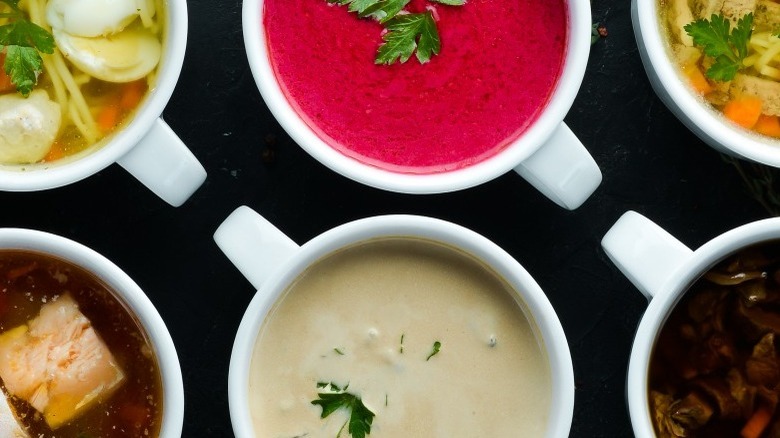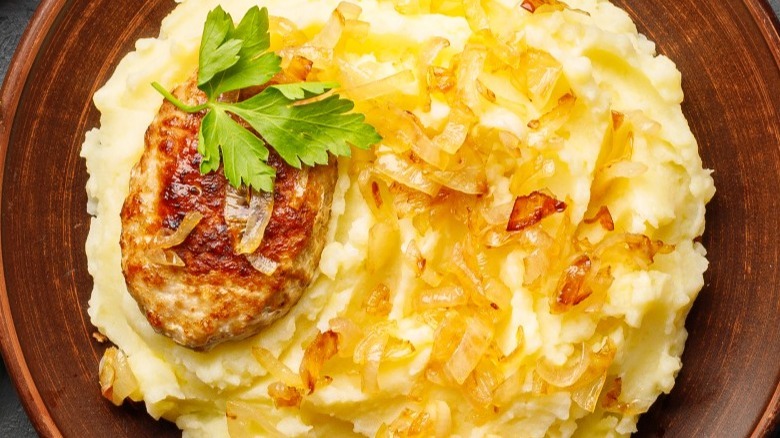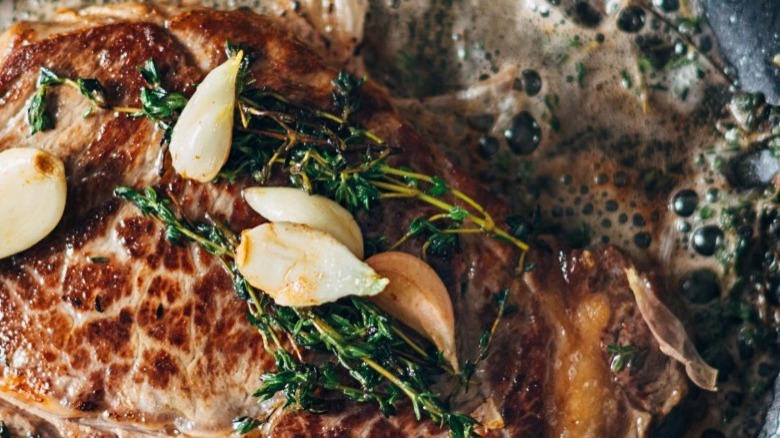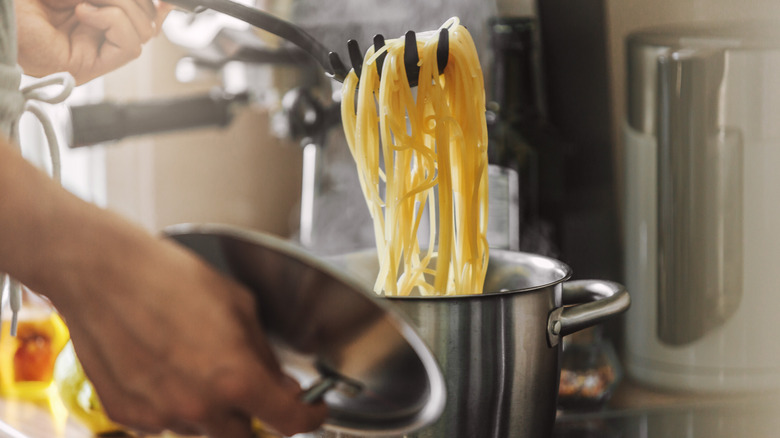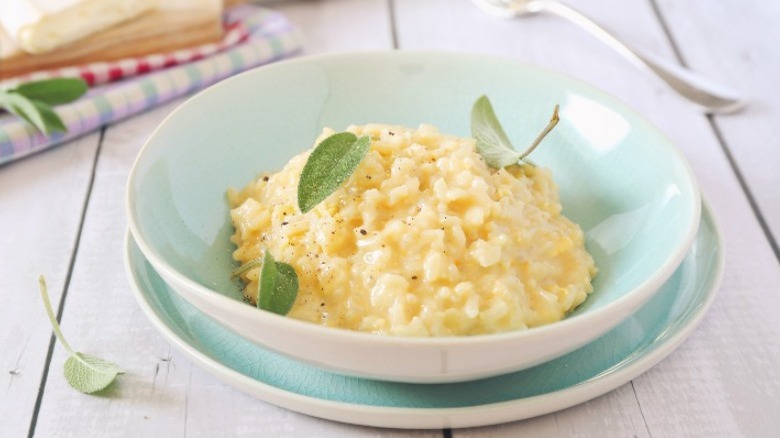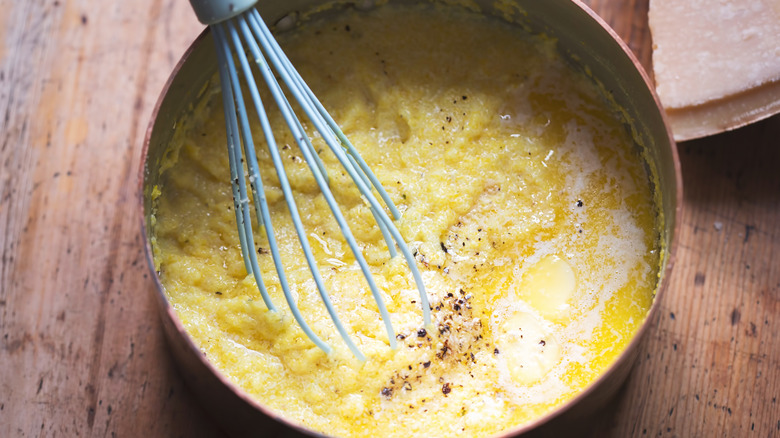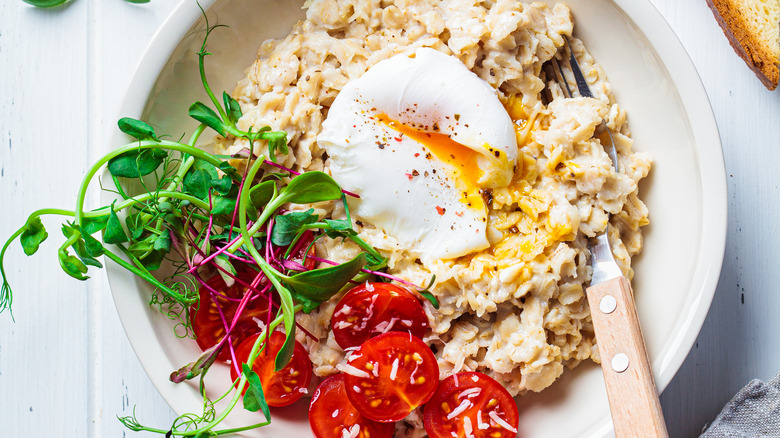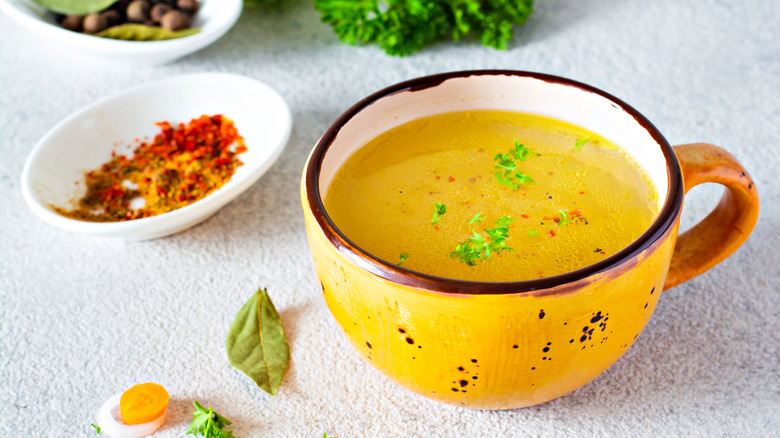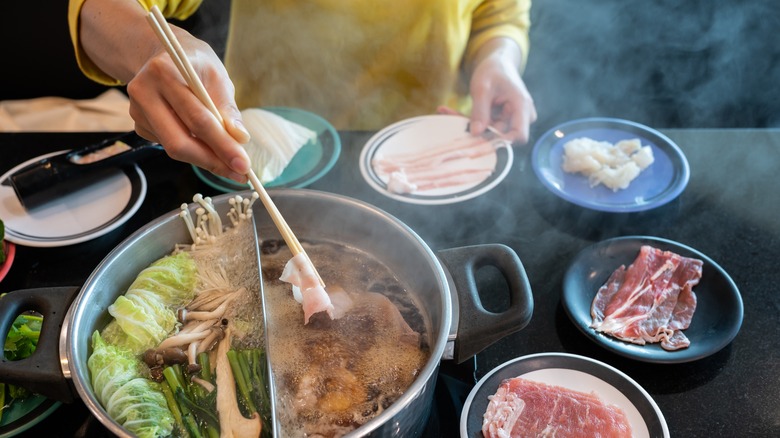The 12 Absolute Best Uses For The Bone Broth In Your Pantry
The inclusion of bone broth in the human diet is almost as old as humanity itself, according to The New York Times, but it seems like only within the last decade it has rocketed to popularity as one of the many ubiquitous wonder foods that no pantry should be without. At first blush, the uses for bone broth seem obvious, but this versatile ingredient goes beyond the soup bowl.
It should be noted that bone "broth" is actually a misnomer. Traditionally, broth is made from boiling meat and vegetables in water until the liquid is flavorful. However, because it's made from simmering vegetables, meat, and bones, bone broth is actually a stock (via Healthline). That extra ossified ingredient and a longer cooking time (anywhere between 4 to 24 hours) elevate bone broth above and beyond your standard cooking liquid, and it's what makes it so useful in your culinary endeavors. Whether you're cooking weeknight pasta, preparing Thanksgiving sides, or simply want to step up your soup game, here are the best ways to take advantage of the bone broth in your pantry.
It's an ideal soup base
Whether you prefer a thinner base or a creamy chowder, bone broth will give your soups and stews the extra "oomph" to set them apart. Bone broth is cooked down for hours, imbuing it with extra flavor and nutrients, both of which are an important foundation for any soup recipe. A versatile meal, practically made for meal prepping, and easy to freeze for future use, soups go beyond a starter course and can shine as an entrée.
Stay light with a simple cup of miso, add noodles and slice of pork for a hearty bowl of ramen, or combine with almonds, spinach, and other assorted treats from the garden with our chilled bone-both gazpacho recipe. Blending vegetables into soup to sip on throughout the day is an easy way to ensure you're getting all the recommended servings into your diet. Bone broth fortifies these soups with extra protein and amino acids, providing essential nutrients. Sipping on a brothy soup is also an excellent way to keep yourself hydrated if you can't remember to drink water (the struggle can be real).
Pump up the nutrients in your mashed potatoes
Take your mashed potatoes recipe to the next level by adding bone broth. Bone broth is a source of important nutrients such as collagen, which Healthline has reported to be beneficial for your skin and joint health. Your standard mashed potato side, while considered to be one of the most popular comfort foods, could definitely use the healthy boost.
The meaty flavor of the bone broth will also elevate the flavor of the potatoes, making the traditional pairing of steak and potatoes all the more heavenly. Once your spuds have been boiled, slowly add your butter and broth while mashing them to your desired consistency. Make sure the broth is hot to make the mashing easier. This can also reduce the calorie content of this carb-heavy meal as well if you're counting.
Mashed potatoes are also easy to digest when you're feeling sick. By blending broth into your potatoes, you're making sure to eat a more balanced meal even if you feel you can't stomach anything more than the basics.
Make use of all the free flavor by deglazing your pan
If you don't deglaze your pan after searing your food, you're missing out on a world of flavor and the simple joy of pan sauce. Pan sauce utilizes all the juices and caramelization left behind in the hot pan after you've cooked your meat or vegetables. Instead of rinsing your pan drippings from down the drain, treat yourself to an easy gravy.
Ever notice the brown bits stuck to the bottom of your pan when you flip your steak, chicken, or roasted veg? Those crispy bits are called fond and they are a chef's best friend. They are a result of proteins caramelizing over heat, and caramelization is the source of a lot of flavor. That's why you should always deglaze your pan when caramelizing onions or other ingredients. While your pan is still hot, throw in a splash of bone broth and swirl it around until fond comes off the bottom of the pan. Add a dollop of butter for richness and you've made yourself the world's simplest sauce! Pour it all over those bone broth mashed potatoes you made earlier.
Swap out the water when you boil pasta
Boiling noodles in water is a missed flavor opportunity, not to mention that water adds nothing nutritionally to your pasta. Use bone broth as your cooking liquid next time, especially with dense pastas such as gnocchi and orecchiette, which are flavor sponges.
It's an old culinary trick to add a ladle of starchy pasta water to thicken the accompanying sauce, and the savory bone broth will kick up the flavor of both meal components. For additional flavor, add a bouquet garni to the broth while it boils. The fresh herbs will steep into the water and the pasta while it cooks, making even a quick weekday dinner taste like it came out of a gourmet kitchen.
For an even easier weeknight dinner option, boil your hearty pastas such as gnocchi, tortellini, or macaroni in the broth, then serve it directly into a bowl. The starches from the pasta will have enriched the broth and you'll have an easy soup with no draining or multiple pans required.
Make show-stopping risotto with velvety texture
Risotto is a labor of love, requiring constant stirring and the gradual addition of liquid. A deceivingly simple dish in gourmet clothes, most people enjoy serving it on special occasions to wow their guests. Don't sell your efforts short by using water and robbing the rice of flavor. There's a reason that using stock such as bone broth is essential for cooking risotto.
Beyond the boosted taste, though, is the added benefit of the fat and collagen content of bone broth. Collagen comes from the slow dissolution of connective tissue and in liquid form it provides an almost creamy texture. The longer bone broth is cooked, the more gelatin and collagen is extracted from the bones themselves, giving the broth its distinctive rich mouthfeel. It is literally liquid gold when it comes to otherwise elusive nutrients.
Perfectly cooked risotto should be creamy and full-bodied and bone broth will help to achieve that result. Your guests will swear that Jamie Oliver is hiding in your kitchen.
Elevate the flavor and nutrition of polenta
In the same vein as risotto, polenta is another dish that requires copious amounts of cooking liquid, and why should you settle for water? Like most porridges, polenta originated back in the 1600's as the main staple of Italian peasant and soldier diets (via Life in Italy). Though it's very filling, polenta lacks complex nutrition, a gap that bone broth can seamlessly bridge. Modern cuisine has seen these traditional peasant dishes elevated to gourmet levels and now polenta is featured on menus in many fine dining restaurants.
A high-quality bone broth, loaded with collagen, will plump up the gritty cornmeal and leave you with a luxuriously creamy base just waiting to be topped with anything from seafood, to sautéed mushrooms, to beef short ribs. Be sure to deglaze your pans with the extra broth and avail yourself of the bonus sauce you end up getting from it.
Elevate brunch with eggs cooked in bone broth
Scrambled, poached, sunny side up: Everyone has their own preferred egg preparation. Nothing is easier or more indulgent on a weekend morning than cooking up your eggs just the way you like them, and bone broth can help make them even more decadent. Splash some broth into whisked eggs before scrambling to add a dimension of meatiness, or use the broth to poach the egg, infusing it with additional savory flavor. You can even prepare a batch of egg drop soup by heating up the bone broth and slowly whisking raw egg into it.
These protein-packed brunch options are great if you had a particularly wild night before and your hangover needs to be tamed, according to Healthline. Eggs are already practically the perfect food, loaded with essential vitamins and versatile for every meal, and the addition of bone broth makes them virtually unsurpassable.
Pack your breakfast with protein by cooking savory oatmeal
Savory oatmeal might strike you as odd the first time you think about it, but it's only been relatively recently that we have been loading our porridge with sugar and berries (via NPR). Historically, most human cultures have some sort of grain-based staple dish which they serve hot and topped with various vegetables and meats. Starting the day with oatmeal cooked in bone broth ensures that you're getting a dose of protein and vitamins that most sugary breakfast options lack. Stir in some wilted spinach and top with a poached egg (spoiler alert: the egg should be poached in bone broth, too), and you have a meal that will keep you full for hours.
In a pinch, savory oatmeal can replace polenta or risotto in almost any recipe. There are additional benefits to replacing your rice with oats, including a boost in iron (via Livestrong). Much like risotto, oats release their starches as they cook, creating the same creamy texture while shaking up your usual rice-based routine.
Next time you're sick, switch out the tea for broth
When you're feeling under the weather, nothing is more comforting than a big mug of tea. But the next time you get that tell-tale scratchy throat, heat up a mug of bone broth instead.
There's a reason that chicken broth is called "Jewish penicillin" and why older generations often touted it as a miracle cure (via Haaretz). Broth is loaded with vitamins, and it is believed that the slow cooking process of bone broth makes those nutrients even easier to digest, which is a lifesaver when you're feeling your worst. Squeezing in some lemon and dropping in a few slivers of fresh ginger can help settle any digestive ills that might come along, too.
Bone broth also keeps you hydrated due to its high water content, which is of the utmost importance when you're unwell (via CareNow). The natural salts in the broth ensures your electrolytes remain balanced, which helps your body retain water, making the road to recovery much smoother.
Help your muscles recover after an intense workout
All those nutrients that help with healing when you're sick? According to the Harvard School of Public Health, they're also amazing for your post-workout recovery.Sipping on bone broth after exercise is believed to help aid in muscle recovery and joint health due to its collagen and gelatin content (via National Library of Medicine). Bone broth is high in amino acids which come from the marrow leeched from the bones during the cooking process. Amino acids are integral to building muscle tissue and repairing any damage or injury incurred during exercise. Amino acids are also an anti-inflammatory which helps to reduce any swelling that might occur during the healing process.
Bone broth hydrates and replaces lost electrolytes, like a more satisfying sports drink. Hot or cold, swap out that fruity, sugary post-workout drink for bone broth to replenish your body's muscles and joints and keep you in fighting shape.
It's a powerhouse smoothie ingredient
If the notion of drinking broth right after a workout doesn't sound appetizing, you can still reap all the benefits of bone broth while masking its savory flavor. Use bone broth as the liquid in your smoothies instead of milk (whether almond, oat, flax, or dairy). Blending greens, fruit, and ice into your cold bone broth will give you the creamy smoothie that you're used to, but feed your muscles all the beneficial collagen and gelatin. While it might seem counterintuitive to add savory broth to a sweet smoothie, you'll be surprised how nicely the meaty flavor plays with all your favorite fruits (via Today).
Bone broth's salt heightens the sweetness in your favorite fruits and adds a solid earthiness to your workhorse vegetables, like carrots, beets, and avocados. The liquid's versatility means that you can add it to any standard smoothie recipe and increase your protein and amino acid intake when you otherwise would be missing out.
Bring family and friends together around a hot pot
Do you have a fondue set gathering dust? Clean it off and repurpose it as a hot pot crock. A traditional Chinese hot pot is enjoyed as a social meal with a boiling pot of broth at the center and lots of raw ingredients just waiting to be cooked.
Infuse your bubbling bone broth with ginger, star anise, and garlic, then cook your desired ingredients. The best thing about hot pot is that everyone gets to design their own meals while sharing in the cooking experience. If you want to get extra creative, try using different types of bone broth to create an endless flavor spectrum for all your ingredients. Fish, lamb, and beef broths are excellent starting bases for your hot pots.
Set your table with an array of vegetables: cabbage, sliced carrot, asparagus, and onion are popular choices. And don't forget the meat! Thinly sliced pork and steak are commonly served at hot pot restaurants, along with shrimp and clams.

